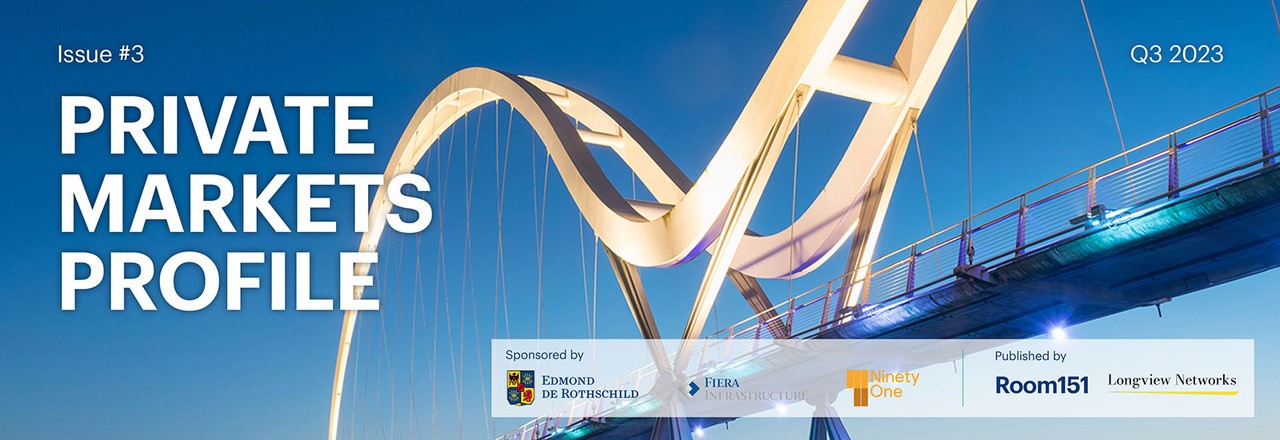Border to Coast, which manages the assets of 11 partner funds, has more than 20% of its portfolio invested in private markets. Room 151 caught up with deputy CIO Mark Lyon to discuss his outlook for the sector.
Private markets play a big role in your investment portfolio: what sort of assets have you invested in?
Since we launched in May 2019, we have received £12bn in commitments from our partner funds. As of 31 March 2023, approximately £9bn has been committed to underlying investments and about £3.5bn has been drawn down.
Broken down by asset class, we have commitments of £3bn in private equity, £4.4bn in infrastructure, £3.2bn in private credit and £1.4bn in climate opportunities. These commitments are determined by the partner funds in relation to their asset allocation decisions. Border to Coast does not make these asset allocation decisions.
To give some examples, in private equity, we have invested predominantly in buyout strategies with some exposure to growth, venture capital and opportunistic funds with notable sector exposures in technology and healthcare.
Our infrastructure assets include a mix of core, core plus and value add funds with significant sector exposures in renewables and digital
infrastructure including a number of co-investments.
In the private credit segment, we have invested predominantly in senior direct lending with some exposure to real assets and opportunistic debt.
As for the climate opportunities strategy, this includes a mix of infrastructure, buyout, growth and credit funds with exposure to areas
including traditional renewables, hydrogen, storage and grid infrastructure, energy efficiency and decarbonisation technologies.
Why is your private markets strategy broken down into different stages?
The typical private markets strategy will have a three-year investment period. But for a couple of reasons, our partner funds wanted the ability to make annual commitments. This is partly because some are new to the asset class and wanted to scale up quicker, but there were
also those who have been in private markets for some time through legacy investments and were getting pretty sizeable distributions, so
they wanted the flexibility to be able to make annual commitments to smooth out their allocation.
Fundamentally, to get a diversified portfolio, we deploy the capital from each capital raise over a 12 month period but seek to achieve such diversification over three years; that is where the series comes in. We want the visibility and the time to deploy our capital over a three-year
investment period.
What role are co-investments playing in your broader private markets strategy?
We access co-investments in a number of ways. On the one hand, we have individual co-investments – we have reviewed around 100
opportunities, predominantly in infrastructure and completed six to date – these include a UK biomass plant, an infrastructure operator
and developer with a global portfolio of assets, a US solar and battery storage project, a US telecoms tower portfolio, a US data centres
portfolio, and a European waste investment.
We also have a bespoke co-investment fund with an infrastructure manager which receives deal flow from its suite of funds – this is an
arrangement we are looking to replicate with a couple of other key infrastructure relationships.
In addition, we also have co-investment funds in private equity as well as co-investment sidecars in private equity and private credit – these receive an overage from an investment in the main fund.
These investments serve to reduce the overall fee burden of the programme whilst providing suitable diversification across the portfolios
and access to interesting opportunities offering attractive risk-adjusted returns.
How do you integrate ESG criteria in your private market strategy?
We integrate ESG and carbon considerations fully into our investment process. We issue an ESG due diligence questionnaire as part of our initial due diligence, which serves to understand how managers incorporate ESG into their process including investment selection, value creation and reporting. This informs the completion of an ESG scorecard to assess the managers’ strengths and weaknesses in this area. This is supplemented post-investment with an annual ESG questionnaire, regular review of the managers’ ESG reporting, and interactions with managers when ESG issues arise.
We are very keen on improving the quality of ESG and carbon reporting and are members of the ESG Data Convergence Initiative, which
we hope will become the industry standard approach to data provision in private markets.
With rates rising, where do you see growing opportunities and risks in private markets?
Within private equity, we are acutely aware of the impact of rising rates on entry and exit multiples, lower debt levels and higher costs
of debt, on current return expectations. This environment should favour managers with operational value add capabilities and strong
sourcing networks.
Within infrastructure, assets with visibility of returns through, for example, contractual arrangements would be expected to be more
resilient.
Within private credit, the variable rate nature of direct lending is resulting in relatively attractive returns for new lending as base
rates rise.
The balance of power is moving in favour of lenders who can negotiate better terms and covenant protections. Default rates are likely to rise, which means that a manager’s underwriting standards and workout capabilities will be more important.
Within our climate opportunities fund, there are a wide range of opportunities in established and new technologies
supported by an increasing investor focus on climate transition as more make net zero commitments, as well as significant incentive packages such as the EU Green Deal and US Inflation Reduction Act.
How are your partner funds adjusting their strategic asset allocation based on that?
We have seen our partner funds increase their exposure to private credit, possibly due to improved funding ratios and a desire to improve income as the funds mature, but also possibly due to the more attractive environment with higher rates and higher potential returns.
We also expect them to increase their exposure to our climate opportunities fund as more and more of them make net zero commitments.
This interview was first published in our quarterly Private Markets Profile, you can find the full issue on private market investment in UK infrastructure here.














